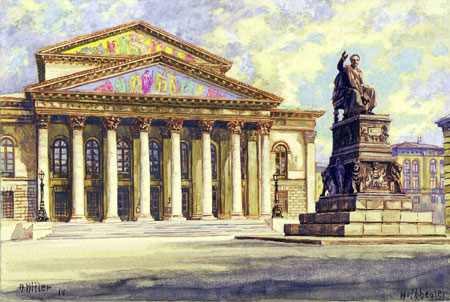|
|
||
|
December 16,
2020 - Droog Magazine periodical for investigative
journalism The strange business of selling fakes, forgeries and other concoctions attributed to Adolf Hitler (1889-1945) and other Nazi criminals. Introduction Even
though the Hitler diaries scandal had made it quite
clear that there were many fake Hitlers on the market,
the trade in the "authentic" Hitler watercolors and
other objects attributed to Hitler continued. 23-05-2005 - "Hitlers" offered by David Irving Four 'Hitler' watercolors were offered for sale on the site of the David Irving. The owner was said to be a Charles T. from Cleveland, Ohio, US. The alleged provenance was "from the estate of Frau Prof. Gerdy Troost". Mrs Troost (1904-2003), had been Hitler's favorite interior architect.
 Signed "A. Hitler, 1909" -
but Hitler didn't produce any watercolors
at all in 1909. 
Signed "A. Hitler, 1914",
titled "Wien, Karlskirche" - but Hitler
lived then in München, where he depicted
only buildings from Munich. This work was
auctioned again in November 2020, by
Affiliated Auctions, Tallahassee
(Florida, USA). The owner must have known
it was a forgery, as the start price was
only $380. It was sold for $1,650 to an
American collector.

According to David Irving
this work, titled "Siegestor München",
was made in 1919 - long after Hitler
ceased producing watercolors.
02-11-2005 - Jefferys sells a "Hitler" for £5,200
The Guardian: "There were only two bidders, both of whom prefer to remain anonymous: a London-based collector who registered an advance bid of £5,000, and the local man who beat him to the punch." "The painting was put up for sale by Mike Palmer, a 50-year-old ferryman from nearby Torpoint, who bought it, he says, for "a lot less than it went for this week". An erstwhile autograph collector, Palmer claims to have long since graduated from the signatures of mere celebrities to the chattels of figures with more historical weight, amassing former belongings of the likes of Erwin Rommel and Albert Speer." (...) "The painting, apparently torn from a sketchbook, came to the west country via a German friend of Otto Gunsche, which presumably only heightened its warped allure. As Hitler's adjutant, Gunsche was one of the last people to have seen the Führer alive; he was given the job of burning Hitler's and Eva Braun's corpses after their suicides (he was portrayed in Olivier Hirschbiegel's film Downfall). Captured by the Russians, Gunsche was held in Soviet captivity for a decade, where he endured daily interrogations at the personal behest of Stalin. He died in 2003." (...) "Ever since [1945], a number of works have drifted on to the open market, usually commanding prices of between £5,000 and £20,000. Given Hitler's awful historical importance, such prices may seem surprisingly small. But this reflects the refusal of most major dealers to go near him ("We won't have anything to do with Hitler," a Sotheby's spokeswoman tells me), and the fact that, relative to the stature of his other "achievements", his work with a paintbrush is negligible." (...) John Harris. The Guardian, London, 07-11-2005. https://www.theguardian.com/artanddesign/2005/nov/07/art.secondworldwar The article written by John Harris was a mix of proper reporting of what had happened and what concoctions about the provenance were told. But it also repeated the myths about Hitler's artistic production: "When he was resident in Vienna between 1907 and 1912, he specialised in knocking out postcards and "frame-fillers", sometimes completed at the rate of three a day. After moving to Munich in 1913, he slowed his pace of work and increased the size of his paintings: among his efforts from this period was a watercolour of Rotterdam cathedral, and a run of depictions of local churches, sold to wedding parties. Frau Popp, Hitler's Munich landlady, later recalled him "sticking to his work for hours" and "going out of a morning with his portfolio under his arm, in search of customers". As far as we know now, Hitler produced only "watercolors' in Vienna (1910-1913) and in Munich (1913-1914), as well as one in Linz (1906). These were mostly small sized, about A4. It is thought that he colored in early 1910 an unknown number of printed black and white postcards, before he started to produce "frame-fillers". See also. Hitler watercolour fetches £5,200. BBC News, Lonodon, 03-11-2005. http://news.bbc.co.uk/2/hi/uk_news/england/cornwall/4403618.stm. News brief. ["Rare, signed watercolor by Hitler"]. Jewish Telegraph Agency, 09-11-2005. https://www.jta.org/2005/11/09/archive/a-rare-signed-watercolor-by-hitler-was-sold Adolf Hitler watercolor sells for GBP 5,200. Art Daily, [November 2005]. https://artdaily.cc/news/15396/Adolf-Hitler-Watercolor-Sells-For-GBP-5-200-#.Xx_7j54zbIU © Compilation Bart FM Droog, 2020. |
||
| |
||
| |


